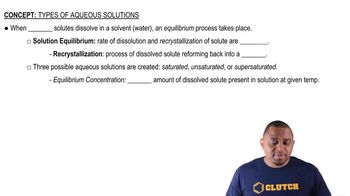Use the data to calculate the heats of hydration of lithium chloride and sodium chloride. Which of the two cations, lithium or sodium, has stronger ion–dipole interactions with water? Why?
Ch.14 - Solutions

Chapter 14, Problem 41
A solution contains 25 g of NaCl per 100.0 g of water at 25 °C. Is the solution unsaturated, saturated, or supersaturated? (Use Figure 14.11.)
 Verified step by step guidance
Verified step by step guidance1
Identify the solubility of NaCl in water at 25 °C from Figure 14.11. This figure typically shows the maximum amount of solute that can dissolve in 100 g of water at a given temperature.
Compare the given amount of NaCl (25 g) to the solubility value obtained from the figure for 25 °C.
If the given amount of NaCl is less than the solubility value, the solution is unsaturated.
If the given amount of NaCl is equal to the solubility value, the solution is saturated.
If the given amount of NaCl is greater than the solubility value, the solution is supersaturated.

Verified video answer for a similar problem:
This video solution was recommended by our tutors as helpful for the problem above.
Video duration:
1mWas this helpful?
Key Concepts
Here are the essential concepts you must grasp in order to answer the question correctly.
Solubility
Solubility is the maximum amount of a solute that can dissolve in a given amount of solvent at a specific temperature. For NaCl in water at 25 °C, solubility is typically around 36 g per 100 g of water. Understanding solubility helps determine whether a solution can hold more solute or if it has reached its limit.
Recommended video:
Guided course

Solubility Rules
Saturated Solution
A saturated solution is one in which the maximum amount of solute has been dissolved in the solvent at a given temperature. Any additional solute added will not dissolve and will remain as a solid. Identifying whether a solution is saturated is crucial for classifying it as unsaturated or supersaturated.
Recommended video:
Guided course

Types of Aqueous Solutions
Supersaturated Solution
A supersaturated solution contains more solute than can typically dissolve at a given temperature, achieved by heating the solution and then cooling it carefully. This state is unstable, and any disturbance can cause the excess solute to crystallize out. Recognizing this concept is important for understanding the behavior of solutions under different conditions.
Recommended video:
Guided course

Types of Aqueous Solutions
Related Practice
Textbook Question
Textbook Question
Potassium nitrate has a lattice energy of -163.8 kcal/mol and a heat of hydration of -155.5 kcal/mol. How much potassium nitrate has to dissolve in water to absorb 1.00⨉102 kJ of heat?
Textbook Question
A solution contains 32 g of KNO3 per 100.0 g of water at 25 °C. Is the solution unsaturated, saturated, or supersaturated? (Use Figure 13.11.)
Textbook Question
A KNO3 solution containing 45 g of KNO3 per 100.0 g of water is cooled from 40 °C to 0 °C. What happens during cooling? (Use Figure 14.11.)
Textbook Question
A KCl solution containing 42 g of KCl per 100.0 g of water is cooled from 60 °C to 0 °C. What happens during cooling? (Use Figure 14.11.)
